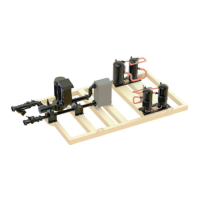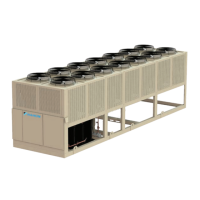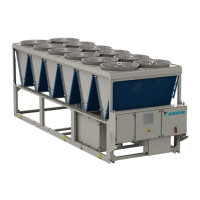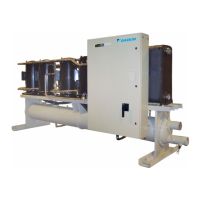www.DaikinApplied.com 15 IOM 1207-6 • TRAILBLAZER
®
MODEL AGZ CHILLERS
Inlet Strainer Guidelines
An inlet water strainer kit must be installed in the chilled water
piping before the evaporator inlet. Several paths are available
to meet this requirement:
1. All units with the pump package option include a strainer
shipped loose for eld mounting. Refer to Figure 21 on
page 14
2. For remote evaporators - a eld-installed kit shipped-
loose with the unit is available for all unit sizes and
consists of:
• Y-type area strainer with 304 stainless steel perforated
basket with perforations no larger than 0.063”
(1.6 mm) diameter, groove type pipe connections and
strainer cap.
• Extension pipe with two Schrader ttings that can be
used for a pressure gauge and thermal dispersion ow
switch. The pipe provides sucient clearance from the
evaporator for strainer basket removal.
• ½-inch blowdown valve
• Two grooved clamps
Both are sized per Table 2 and with the pressure drop shown in
the Strainer Pressure Drop graph. Connection sizes are given
in the Dimensions and Weights section on page 29 for units
with remote evaporators and page 45 for pump package
units.
3. A eld-supplied strainer that meets specication and
installation requirements of this manual.
Table 2: Strainer Data
Trailblazer
®
Model
Strainer Size
in (mm)
Maximum
perforation size
in (mm)
030-070E 2.5 (64) 0.063 (1.6)
075-130E 3.0 (76) 0.063 (1.6)
140-180E 4.0 (102) 0.063 (1.6)
191-241E 6.0 (152) 0.063 (1.6)
Figure 22: Strainer Pressure Drop
Water Flow Limitations
Constant Evaporator Flow
The evaporator ow rates and pressure drops shown on Table
3 on page 19 for various system designs. The maximum
ow rate and pressure drop are based on a 6°F temperature
drop. Flow rates above the maximum values will result in
unacceptable pressure drops and can cause excessive
erosion, potentially leading to failure.
The minimum ow and pressure drop is based on a full load
evaporator temperature drop of 16°F. Evaporator ow rates
below the minimum values can result in laminar ow causing
low pressure alarms, scaling and poor temperature control.
Variable Evaporator Flow
Reducing evaporator ow in proportion to load can reduce
system power consumption. The rate of ow change should be
a maximum of 10 percent of the ow per minute. For example,
if the maximum design ow is 200 gpm and it will be reduced
to a ow of 140 gpm, the change in ow is 60 gpm. Ten percent
of 200 gpm equals 20 gpm change per minute, or a minimum
of three minutes to go from maximum to desired ow. The
water ow through the evaporator must remain between the
minimum and maximum values listed in Table 3 on page 19.
If ow drops below the minimum allowable, large reductions in
heat transfer can occur. If the ow exceeds the maximum rate,
excessive pressure drop and tube erosion can occur. See unit
set point information in “Variable Evaporator Flow” on page
85.
All chilled water systems need adequate time to recognize
a load change, respond to the change and stabilize to avoid
undesirable short cycling of the compressors or loss of
temperature control. In air conditioning systems, the potential
for short cycling usually exists when the building load falls
below the minimum chiller plant capacity or on close-coupled
systems with very small water volumes. Some of the things
the designer should consider when looking at water volume
are the minimum cooling load, the minimum chiller plant
capacity during the low load period and the desired cycle time
for the compressors. Assuming that there are no sudden load
changes and that the chiller plant has reasonable turndown,
a rule of thumb of “gallons of water volume equal to two to
three times the chilled water gpm ow rate” is often used. A
storage tank may need to be added to the system to reach the
recommended system volume. Refer to AG 31-003 for method
of calculating “Minimum Chilled Water Volume”.
The water quality provided by the owner/occupant/operator/
user to a chiller system should minimize corrosion, scale
buildup, erosion, and biological growth for optimum eciency
of HVAC equipment without creating a hazard to operating
personnel or the environment. Strainers must be used to
protect the chiller systems from water-borne debris. Daikin will
not be responsible for any water-borne debris damage or water
side damage to the chiller heat exchangers due to improperly
treated water.
2.5 in
3.0 in
4.0 in
6.0 in.
2.0 in.
0.1
1.0
10.0
100.0
10.0 100.0 1000.0
Pressure Drop ( ft)
Flow Rate (gpm)

